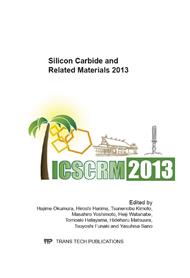[1]
S. Sundaresan, C. Sturdevant, M. Marripelly, E. Lieser, and R. Singh, Mater. Sci. Forum, 717-720 (2012) 949.
DOI: 10.4028/www.scientific.net/msf.717-720.949
Google Scholar
[2]
L. Cheng, A. K. Agarwal, C. Capell, M. O'Loughlin, C. Jonas, J. Richmond, A. Burk, J. Palmour, A. A. Ogunniyi, H. K. O'Brien, and C. J. Scozzie, Mater. Sci. Forum, 740-742 (2013) 978.
DOI: 10.4028/www.scientific.net/msf.740-742.978
Google Scholar
[3]
Y. Sugawara, D. Takayama, K. Asano, R. Singh, J. Palmour, and T. Hayashi, Proc. Int. Symp. Power Semiconductor Devices and ICs, 2001, p.27.
Google Scholar
[4]
D. C. Sheridan, G. Niu, and J. D. Cressler, Solid-State Electron., 45 (2001) 1659.
Google Scholar
[5]
J. B. Fedison, N. Ramungul, T. P. Chow, M. Ghezzo, and J. W. Kretchmer, IEEE Electron Device Lett., 22 (2001) 130.
DOI: 10.1109/55.910619
Google Scholar
[6]
W. Sung, E. V. Brunt, B. J. Baliga, and A. Q. Huang, IEEE Electron Device Lett. 32 (2011) 880.
Google Scholar
[7]
J. H. Zhao, P. Alexandrov, and X. Li, IEEE Electron Device Lett. 24 (2003) 402.
Google Scholar
[8]
H-Y. Lee, M. Domeiji, R. Ghandi, C-M. Zetterling, and M. Östling, IEEE Trans. Electron Devices, 55 (2008) 1894.
Google Scholar
[9]
Q. J. Zhang, A. Agarwal, C. Capell, L. Cheng, M. O'Loughlin, A. Burk, J. W. Palmour, S. Rumyantsev, T. Saxena, M. Levinshtein, A. Ogunniyi, H. O'Brien, and C. J. Scozzie, Mater. Sci. Forum, 717-720 (2012) 1151.
DOI: 10.4028/www.scientific.net/msf.717-720.1151
Google Scholar
[10]
G. Feng, J. Suda, and T. Kimoto, IEEE Trans. Electron Devices, 59 (2012) 414.
Google Scholar
[11]
H. Niwa, J. Suda, and T. Kimoto, Appl. Phys. Express, 5 (2012) 064011.
Google Scholar
[12]
T. Hiyoshi and T. Kimoto, Appl. Phys. Express, 2 (2009) 091101.
Google Scholar
[13]
T. Kimoto, T. Hiyoshi, T. Hayashi, and J. Suda, J. Appl. Phys., 108 (2010) 083721.
Google Scholar
[14]
A. O. Konstantinov, Q. Wahab, N. Nordell, and U. Lindefelt, Appl. Phys. Lett., 71 (1997) 90.
Google Scholar
[15]
N. Kaji, H. Niwa, J. Suda, and T. Kimoto, Jpn. J. Appl. Phys., 52 (2013) 070204.
Google Scholar
[16]
K. Nakayama, A. Tanaka, M. Nishimura, K. Asano, T, Miyazawa, M. Ito, and H. Tsuchida, IEEE Trans. Electron Devices, 59 (2012) 895.
DOI: 10.1109/ted.2011.2181516
Google Scholar


